If you are visiting Japan for the first time, Tokyo alone may feel like a complete Japanese experience. However, I personally think one of the most exciting aspects of visiting Japan is the wealth of destinations waiting beyond its capital.
For those of you eager to venture outside Tokyo, Japan’s rail network is a dream come true. With one of the world’s most extensive and efficient train systems, traveling from city to city is both simple and seamless. The trains allow you to explore Japan’s incredible variety with ease.
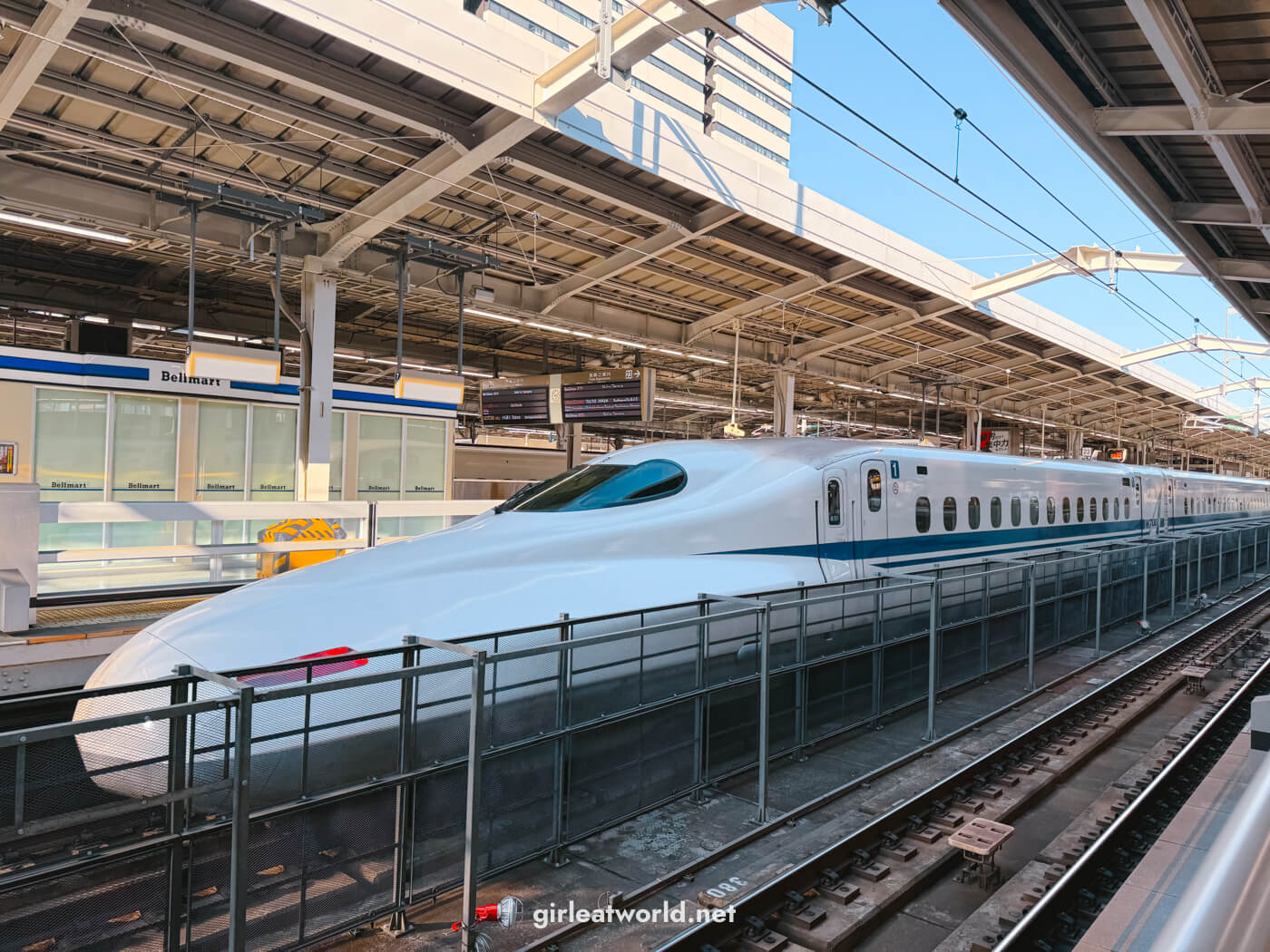
Here are the topics that I will cover in this post:
- Traveling by Train in Japan
- About JR Pass
- Using JR Pass
- About Shinkansen
- Traveling on Shinkansen
Types of Trains in Japan
Japan offers a large variety of train types, each tailored to different travel needs. To help you choose the best option for your journey, let’s explore the different types of trains and what each has to offer.
Below, I’ve sorted the different types of trains based on the speed from fastest to slowest:
| Train Type | What they are | Examples |
|---|---|---|
| Shinkansen | Known worldwide for their speed, efficiency, and comfort, Shinkansen trains are the fastest trains in Japan, reaching speeds of up to 320 km/h (200 mph). They connect major cities in just a few hours. | Traveling from Tokyo to Osaka |
| Limited Express | Limited Express trains operate between cities and regions, making fewer stops than local trains but more stops than the Shinkansen. Limited express trains are commonly used for medium-distance travel. | Narita Express for traveling between Narita Airport and Tokyo or Haruka train for traveling from Kansai International Airport to Osaka |
| Express | Express trains stop more frequently than limited express trains but are still faster than local trains. They are often used for mid-range routes or to connect small cities within a region. | In the Kansai region, the Kintetsu Railway operates express trains connecting Osaka, Kyoto, Nara, and Nagoya. |
| Rapid/Special Rapid | Rapid and Special Rapid trains are faster versions of local trains, skipping certain smaller stations to reach destinations more quickly. Special Rapid trains, often found in the Kansai region, make fewer stops than regular Rapid trains. | JR Special Rapid Service between Osaka and Kyoto skips many stations, making the trip faster than a standard local train. |
| Local | Local trains serves regular daily commuters. It stop at every station along a route, offering the most affordable way to travel short distances within cities or between neighboring towns. | The JR Yamanote Line in Tokyo, which circles the city and stops at major neighborhoods like Shibuya, Shinjuku, and Ikebukuro. |
What to do with your luggage when taking the train
If you’re traveling around Japan for awhile and have a lot of luggage, be prepared before boarding the train.
If you’re traveling with a small or mid-sized suitcase, you can store them on the overhead compartment. However, if you’re traveling with large suitcases, keep on reading!
Luggage Storage in Japanese Trains
There is not much room for large suitcase on the train. On some trains (like the airport express) there is a dedicated luggage storage space, but it is on first come first serve basis. The last row on each train car has space to store 2-3 large suitcase, but only passengers sitting on the last raw may place their luggage there. You need to reserve this seat ahead of time.
Takuhaibin: Send your luggage to your next destination
If there is one thing Japan does well, it’s logistics. When traveling domestically via Shinkansen (bullet train) or even just moving from one hotel to another hotel, many locals opt to send their luggage ahead of time to their accommodation, so that they can travel hands-free without having to mind their luggage around. This service is called Takuhaibin, and it’s available all over Japan. You can even send your luggage ahead of time to the airport before you fly!
Here are a few luggage delivery services for different areas:
- Luggage delivery for Osaka and Kyoto area
- Luggage delivery for Tokyo area
- Luggage delivery for Okinawa area
- Luggage delivery for Sapporo area
All about JR Pass
For as long as I can remember, the JR Pass was touted as a must-buy whenever someone is visiting Japan. Yes, for a while, JR Pass was the most economical way to explore Japan on their famous Shinkansen, aka the ultra-fast bullet train.
This was because the price of JR Pass was heavily subsidized by the government for international tourists, in a bid to make Japan more attractive to visit. But you know the saying – all good things must come to an end. Starting 1 October 2023, the subsidy has been stopped and JR Pass prices have increased by 50-70%.
The new prices make it difficult to justify the Unlimited JR Pass, and more people are starting to ask – Do I really need JR Pass for my upcoming trip to Japan?
I’ll attempt to answer that question while also telling you what I know about JR Pass and traveling on Shinkansen.
What is JR Pass?
Let’s back up a little bit – What is JR Pass?
JR is short for Japan Railways Group, one of the many train operators in Japan. They are the biggest train company in Japan, operating many routes and different trains across the country. Japan Railways is most famous for operating Shinkansen, aka the famous bullet train that can take you to the speed of 300 to 320 km per hour at its peak. Aside from Shinkansen, Japan Railways also operate several other types of trains, such as local trains and express trains.
JR Pass is a rail pass created by Japan Railways Group that gives you unlimited access to Japan Railways trains for long-distance travel via Shinkansen, either in the entire of Japan (Unlimited JR Pass) or for only certain regions (Regional JR Pass). I bolded the JR train part for emphasis since this gets confusing for some people. Although it can take you to most major cities in Japan, JR Pass is only valid for JR trains – not any other trains.
Should I get a JR Pass?
It depends on what you’re planning to do in Japan.
JR Pass shines the most when it’s time to take long-distance trains that take you from one city to another. So, getting a JR Pass generally makes sense ONLY if you are planning to visit multiple cities in Japan.
For example, if you are planning on visiting Tokyo then going to other cities like Osaka, Kyoto, Hiroshima, etc. The train tickets between these cities aren’t cheap. You could potentially save money by using JR Pass.
IC Card: If you are planning to stay in one city, using an IC card and taking local trains will be enough. Read about what IC cards are and how you can use them in Japan – not just for train rides but also as a method of payment!
Deciding whether to get a JR pass or not involves some planning and calculation. You need to look at whether there is a JR route between the cities you want to visit, how much the individual train tickets cost, and tally it up to see how it compares to the price of JR Pass.
When planning my own trip, I usually create an Excel sheet with my planned itinerary for easy calculation. Then, you can check each individual train fare via Klook or Google Maps (I talked about how to do this in a later part of this post) or Hyperdia.
It is also important to not limit yourself to just JR Pass. There are other rail passes in Japan tailored to specific destinations, such as the Kintetsu Rail Pass in Kansai, Kansai Railway Pass, or even Klook Value Rail pass which gives you discounts for Shinkansen rides, just to name a few.
Types of JR Pass
There are two types of JR Pass: Unlimited Whole Japan JR Pass or Regional JR Pass.
1. Unlimited JR Pass
As the name implies, Unlimited JR Pass gives you unlimited rides on ALL JR trains across the country for a validity of 7, 14, or 21 days.
This is why Unlimited JR Pass used to be a requirement when visiting Japan. It was subsidized for international tourists by the Japanese government and was such a good deal that it was a no-brainer to get.
Unfortunately, as of 1 October 2023, this is no longer true. The government has stopped subsidizing JR Pass and the price of Unlimited JR Pass has increased by 70%. Since the price hike, it has become harder to justify the cost of the Unlimited JR Pass, but it could still make sense for certain itineraries where you plan to be constantly on the go.
2. Regional JR Pass
Regional JR Pass, on the other hand, gives you unlimited train rides on the JR trains for a specified region and is usually valid only for up to 5 days.
There are many different types of Regional JR Passes catering to various regions in Japan with different validity, so you need to do your research on which Regional JR Pass fits your itinerary.
Unlike the unlimited JR Pass, Regional JR Passes were not as affected by the price hike, so it could still make sense to get it for your trip.x
How can I buy JR Pass?
I always get my train tickets in Japan from Klook, including the JR pass.
What is Klook? Klook is the leading travel and experiences booking website in Asia. And yes, they are legit! I personally always book my activities through them whenever I am traveling. See my review of Klook here.
If you have determined that getting the Unlimited JR Pass still makes sense for your itinerary, you can buy Unlimited JR Pass via Klook and have it sent to your home before your trip. For the unlimited JR Pass, you DO need to buy it from outside of Japan. It will be mailed to you, so make sure you get it way ahead of time so that it arrives before your trip.
For Regional JR Pass, you can look at this page to find the pass that best suits your itinerary. There are different passes for each region. Some Regional JR Passes are available as E-tickets and don’t need to be mailed. However, some of them do still need to be mailed so make sure to check the delivery method!
Which Shinkansen train can I use with JR Pass?
Shinkansen is the famous Japanese bullet train. It is a much, much faster way to travel than taking a regular train and thus it has become the preferred mode of transport for tourists and locals alike.
Types of Shinkansen trains
There are different types of Shinkansen trains running on the same route. Most of the time you don’t have to worry about it since they are all the same, and will get you from point A to B. However, if you want to use your JR Pass you cannot take Mizuho or Nozomi trains unless you pay an additional fee. Mizuho and Nozomi trains travel faster because they have fewer stops. They also comes more frequently than the other trains. Personally, I didn’t think it was worth the upgrade so I took mostly Sakura and Hikari trains during my trip.
Type of Shinkansen cars: Ordinary car vs Green car
The first-class car on a Shinkansen is called Green car. It features more luxury seats with wider legroom. Green cars tend to be less crowded too, as there are fewer seats in the car.
Is Green Car worth the upgrade? Read about my experience taking the Green Car on Narita Express

However, the default JR Pass is only valid for the Ordinary Car. While it is possible to buy a Green Car JR Pass, I personally did not think it was worth the upgrade since the ordinary Shinkansen cars are already nice.
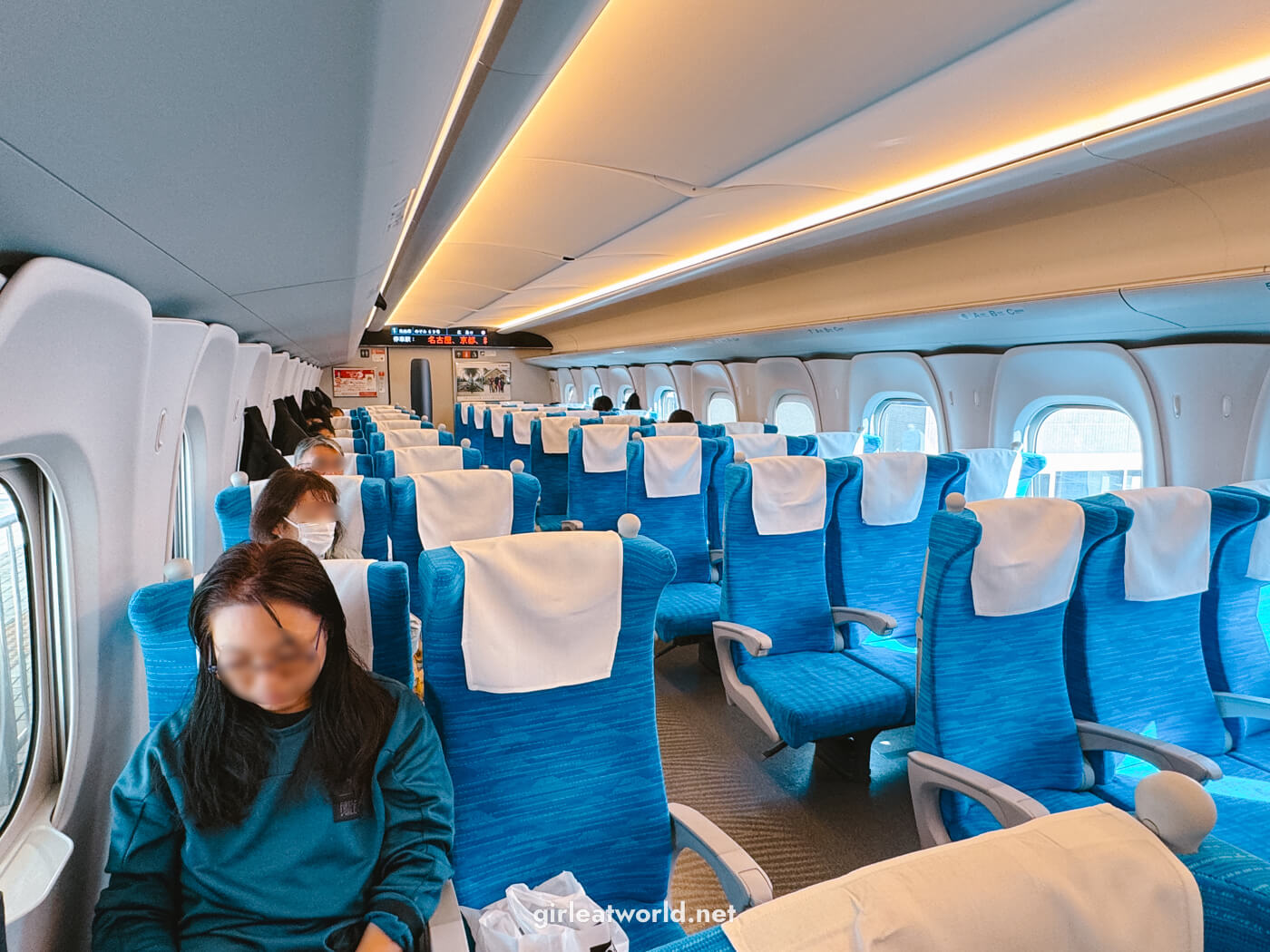
Can I use JR Pass on local trains?
Yes, you can use the pass on certain local trains if they are JR lines. There are several local JR lines in Tokyo, Kyoto and Osaka. When you’re using these trains, you can use your JR Pass (if it has been activated for use) instead of using your IC card balance.
How can identify JR Station?
JR Trains usually has its own station, separate from the rest of the trains.
You can identify them by looking for the JR symbol at the station entrance. Here is an example from the Ochanomizu Station in Tokyo:

Using Google Maps to identify JR trains
Another way to tell is when looking up directions on Google Maps. If the line symbol starts with “J” it might be a JR line. For example, here is what the Saikyo, Yamanote, and Shonan-Shinjuku Line would look like on Google Maps.
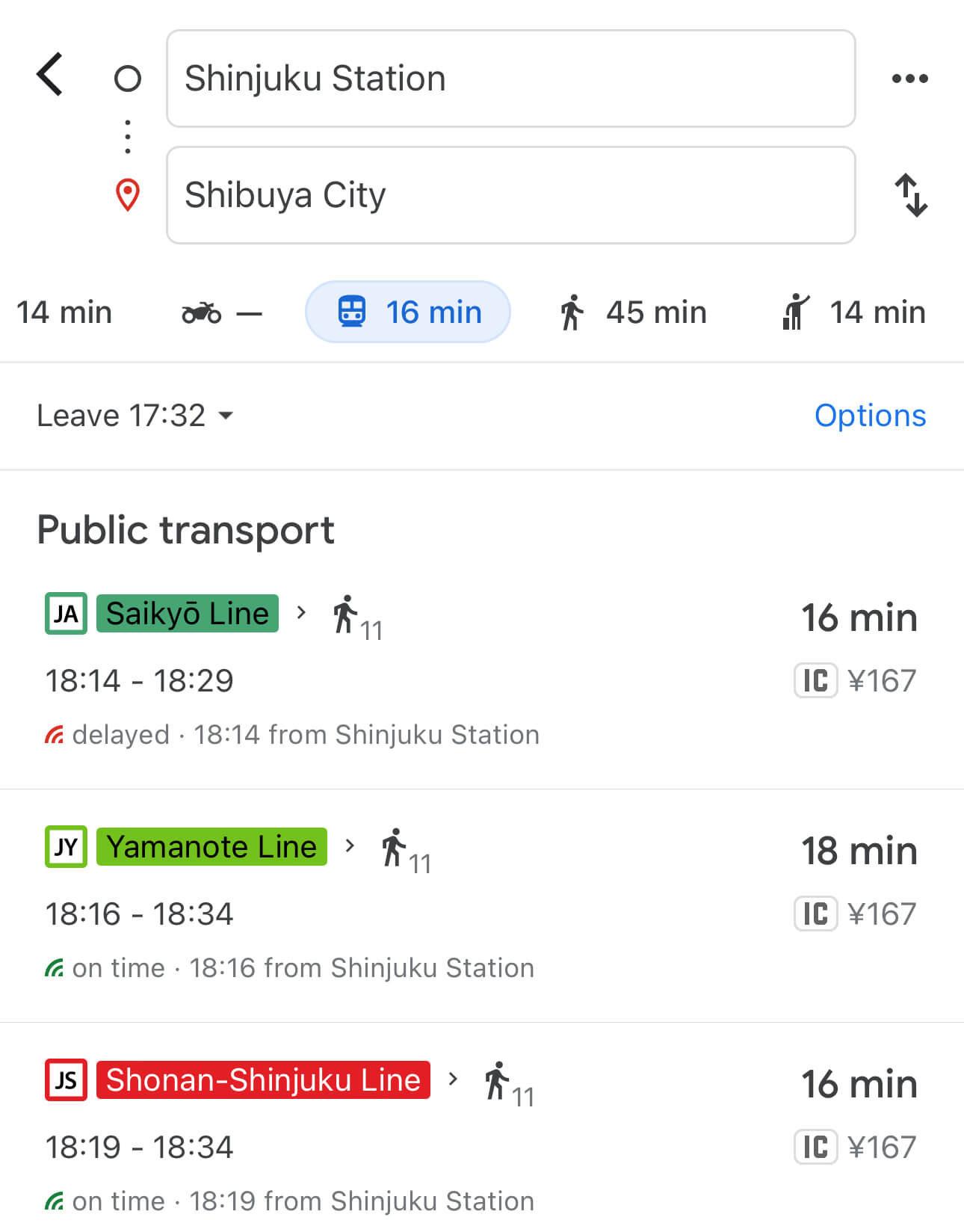
Occasionally, you can use express trains with JR Pass too. Common examples of such trains are the Haruka Express line from Kansai International Airport or Narita Express from Narita Airport. When searching for these trains on Google Maps, you’ll see a JR logo next to it:

How to use JR Pass
Cool, so how do you use the JR Pass once you’re in Japan?
First of all, a voucher for an Unlimited JR pass must be purchased from outside Japan. It will be mailed to you, so you need to sort this out before you go on your trip. Once you have arrived in Japan, and on the day when you want the pass to be activated, you trade in the voucher at any major JR station for the actual pass.
If you’re using Regional JR Pass, some are available as E-tickets and don’t need to be mailed. However, some of them do still need to be mailed so make sure to check the delivery method!
The pass looks like this:
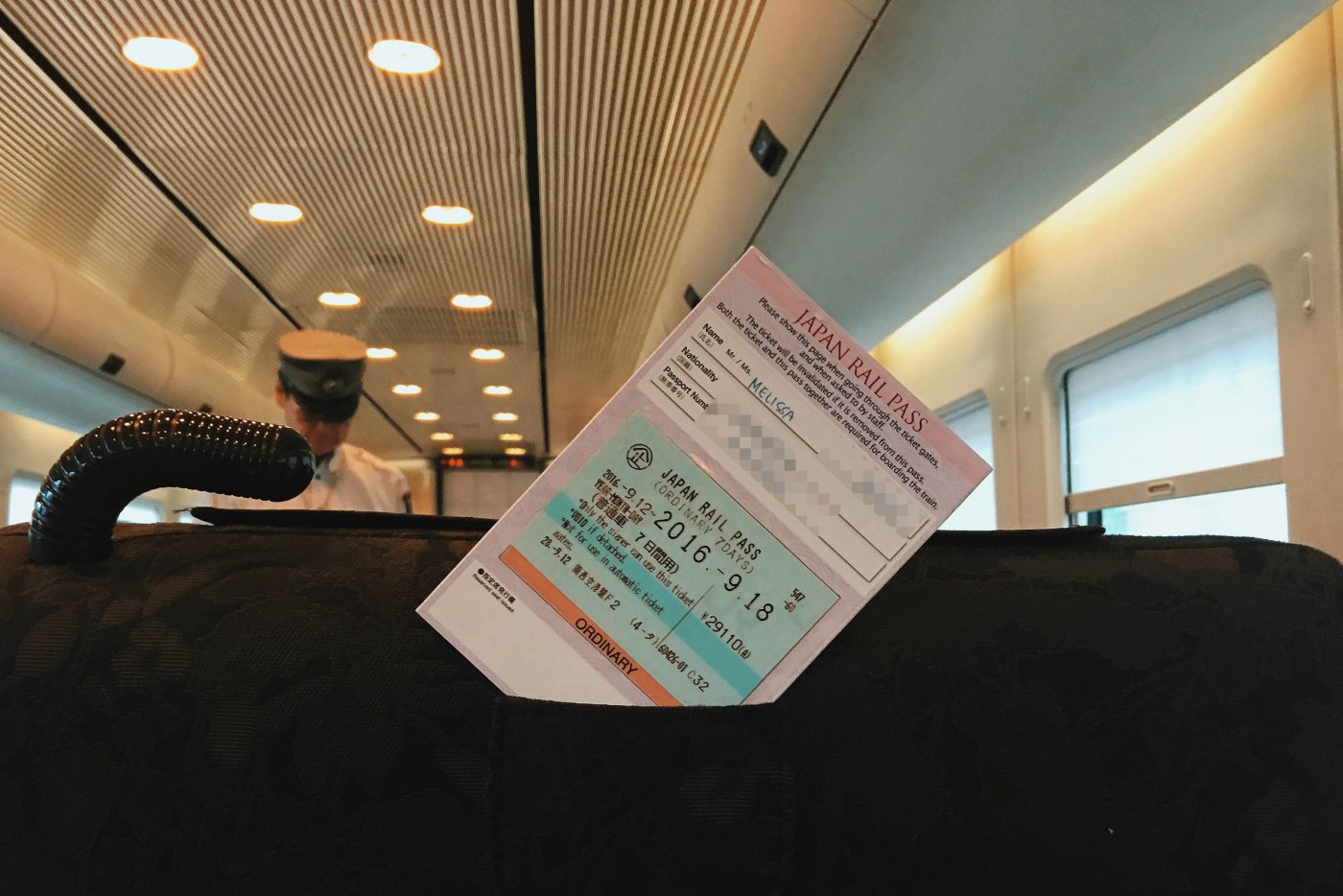
Once you have exchanged your voucher for the pass, you have to keep the pass with you for the duration of your travel and must always bring it with you when you do a train journey. Don’t lose your pass! It’s like your passport to take the train while you’re in Japan.
Whenever you want to use the JR pass, you don’t go through the automated gate like everyone else. Instead, you walk up to any JR station gate and show your pass to the ticket officer, usually to the left or right of the automated ticket gates. The officers will let you through.
How to buy Shinkansen Ticket
If you’ve decided that you won’t be buying JR Pass, you can still purchase train tickets individually. The easiest way to do this is to buy it online via Klook, and redeem the ticket at the station.
🚆 Book train ticket online: Purchase Japan train ticket via Klook for easy redemption at the station once you’re in Japan.
How to find Shinkansen schedule, fare, and train type
Surprisingly, the most user-friendly way is through the good ol’ Google Maps. When searching for directions, use the public transport filter (The icon that looks like a train) and play with the “Depart at” filter to see the next train available. I find their schedule to be quite accurate.
How do you know which train is what type? You can also find out through Google Maps. Here is how:
Using Google Maps to find train schedules, fare and train type
Let’s say you’re traveling from Tokyo to Osaka. The screenshot below is an example of a journey from Tokyo (Shinagawa station) to Osaka (Shin-Osaka) using the Tokaido-Sanyo Shinkansen.
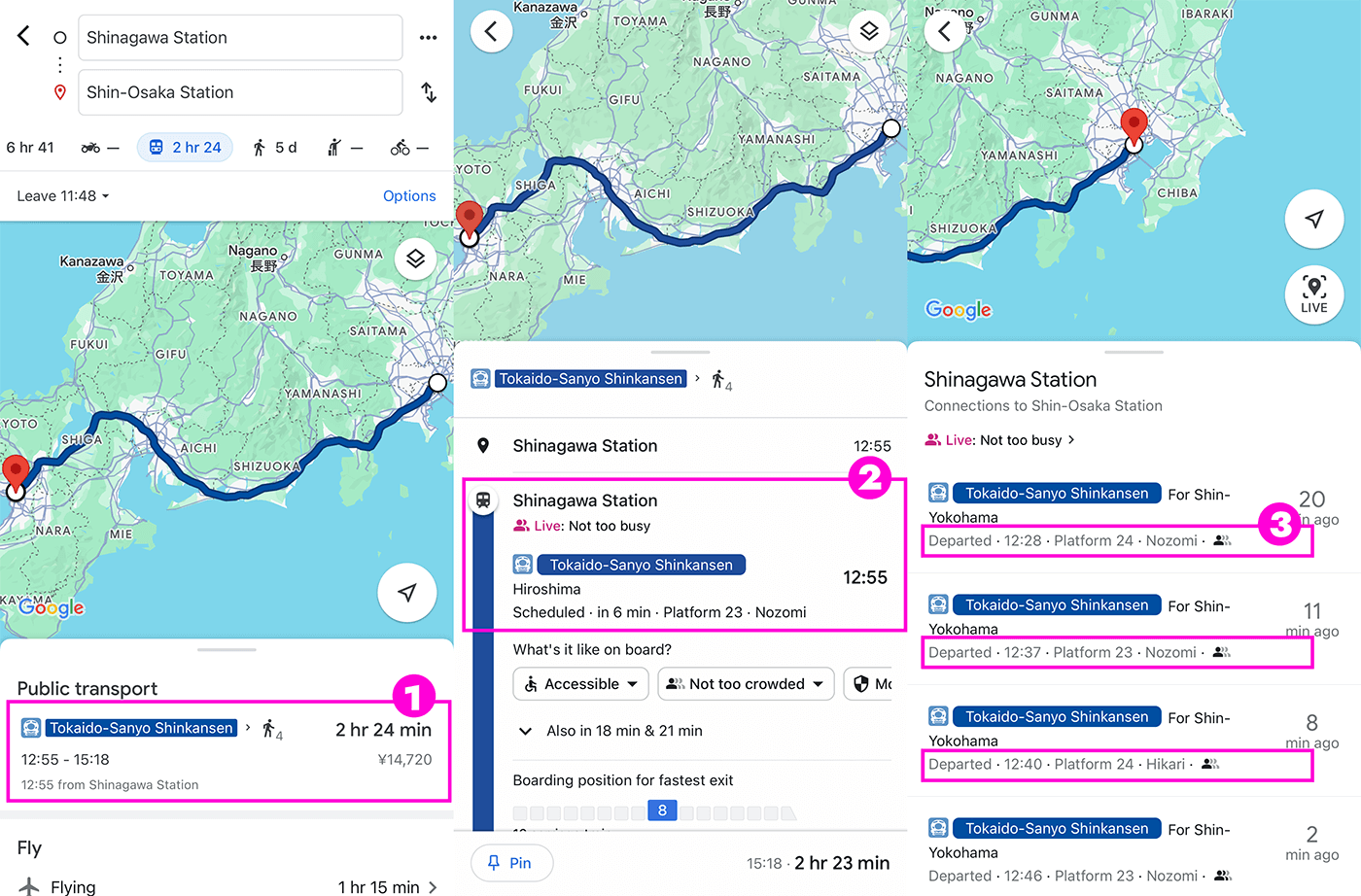
Here is how you can check the schedule and train type on Google Maps:
- To start, I searched for directions from Shinagawa Station to Shin-Osaka Station. Then, I switched the journey type to train (the icon that looks like a train). Then, I clicked on the direction with Tokaido-Sanyo Shinkansen. Note that you can view the train fare here as well.
- On the direction screen, I clicked on the top of the direction. This brings up the train schedule
- On the schedule screen, you can find out when the trains will be departing, from which platform they will depart from, and the train type. In the example above, you can see that the first two trains are Nozomi trains, and the third one is Hikari.
Other than Google Maps, you can go to the station and look at the schedule there or use HyperDia.
Tips on how to travel on Non-reserved Seats on Shinkansen
JR Pass allows you to reserve seats for free, but if you’ve bought a one-way Shinkansen ticket, you might want to be traveling on non-reserved seats as they are cheaper. Non-reserved seats are exactly what the name sounds like – you can’t reserve any seats ahead of time, so the seats are on a first-come first-serve basis.
Here’s what I have learned from my experience taking an non-reserved seat on Shinkansen:
1. Make sure you know ahead of time which cars are designated for non-reserved seating
The digital signboard at any major Shinkansen station tells you all the information you need. It flips between Japanese and English, so don’t worry if you can’t read Japanese! Just wait a few seconds until it flips to English.
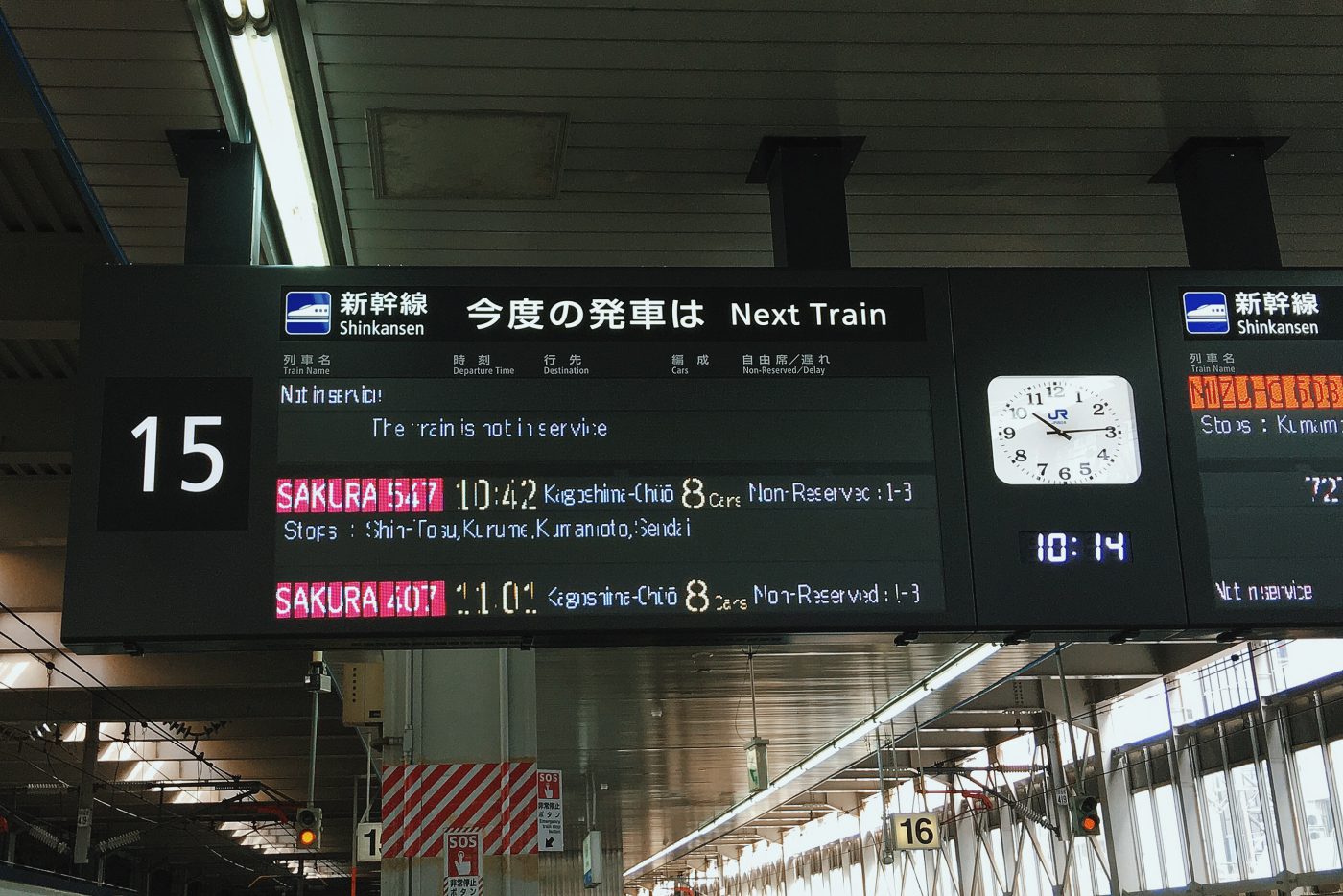
Things to note here are the Non-Reserved car indicator on the far right. In the picture above, it’s Cars 1-3. Also note the train type to the left of it, usually 8 or 16 cars. In the picture above it is 8 cars. I’ll explain why later.
2. Plan to line up 15 to 20 minutes before the trains are scheduled to come
During peak travel time it is entirely possible you might not get to sit next to your travel buddies when the train is full. Or worse, you may not get a seat at all! I have seen people standing up in the space between train cars. So to avoid this, arrive early and allocate some time to line up ahead of the scheduled train arrival time.
How do you line up properly for a Shinkansen? Easy! Get to your train platform and look to the floor to find out where you are supposed to line up – usually, there would be a mark that looks like this:
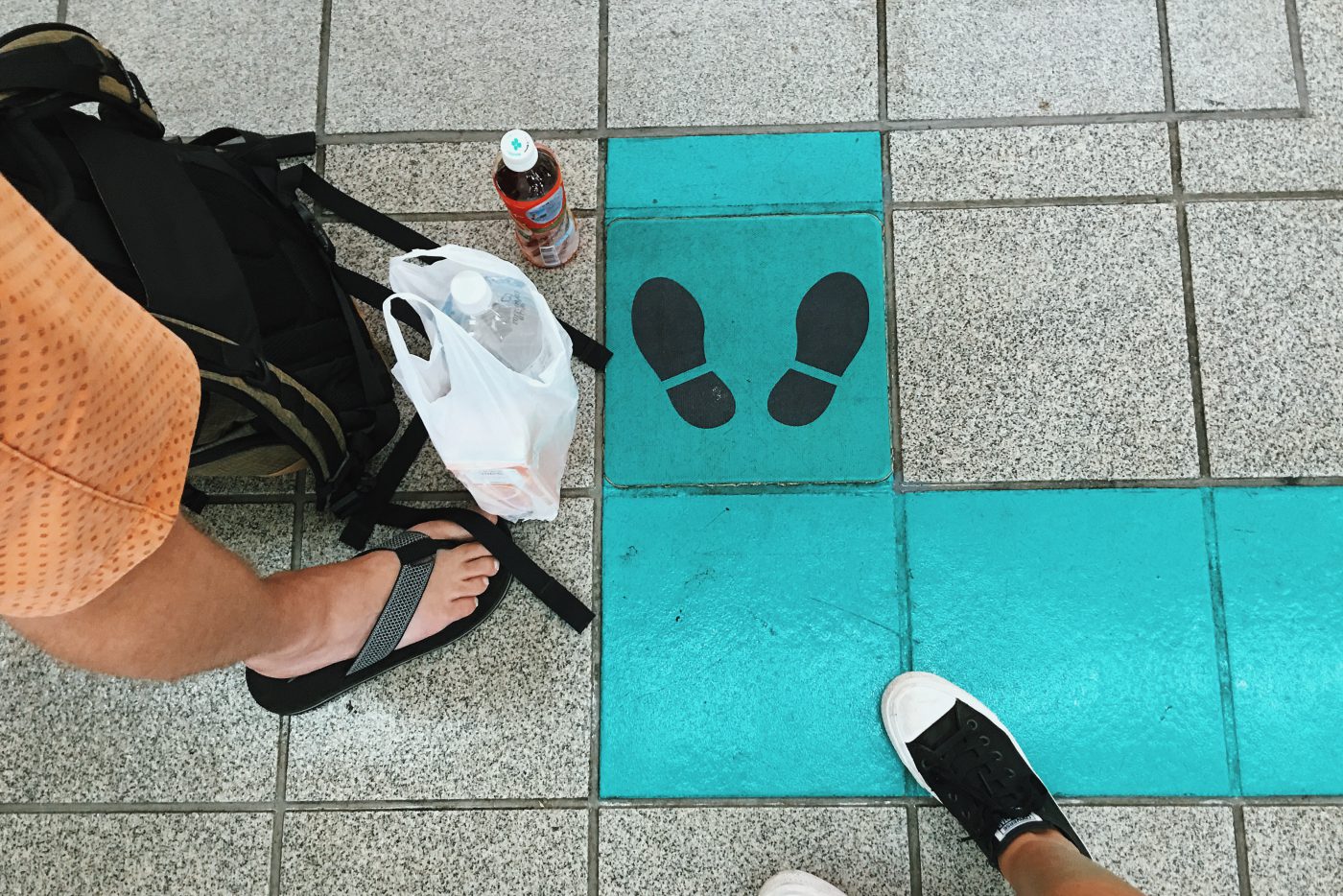
That’s where you’re supposed to line up.
3. Find out which car is the Non-reserved car and where it will stop
Remember when I said to note the Non-Reserved car numbers and train type? This comes in handy when you need to find out where the train will stop, so you know where exactly to line up. On the floor, they would have a sign that looks like this:
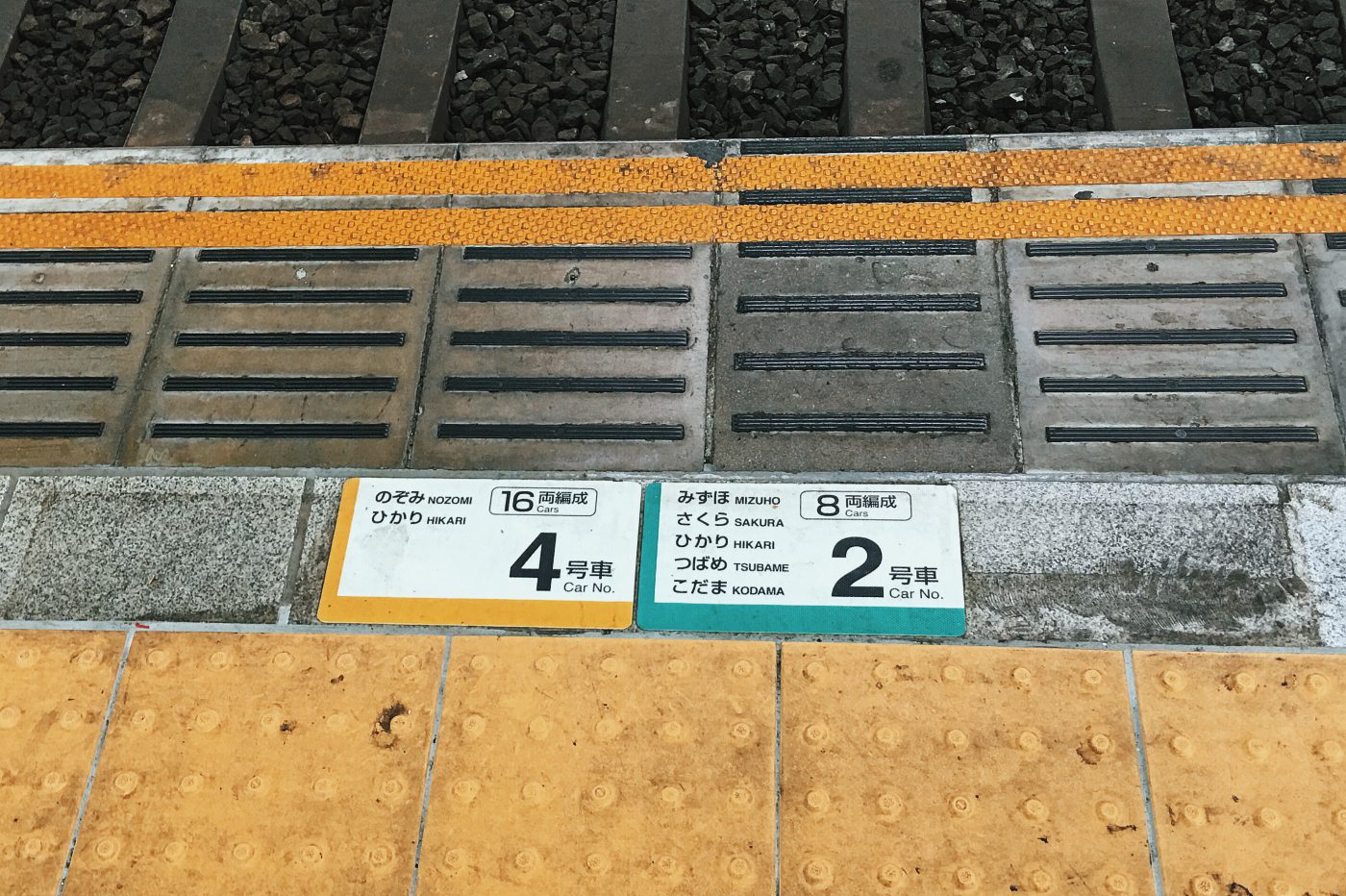
This is when the train type matters – whether it’s the 8 or 16 cars. In the picture above, if your train is an 8-car train then you need to look at the green box. But if your train is a 16-car train then you look at the yellow box. So just match up the car numbers to the Non-reserved cars from the signboard to make sure you are lining up at the correct spot. When the train comes, the door will open up exactly at this spot!
That’s all! It might seem complicated, but after doing this a few times it’s pretty easy 🙂
Ekiben: What to eat when riding on a Shinkansen
Taking the Shinkansen is indeed a convenient way to travel in Japan. But if you ask me, my favorite part about Shinkansen isn’t the train journey itself. It’s what you get to eat when you’re traveling on a long-haul train journey in Japan: Ekiben.
Ekiben is short for Eki Bento, or translated as train station boxed meal. It may not sound appetizing, but it’s not the kind of fast food you might expect. Bento is a healthy pre-packed and nutritionally balanced meal consisting of rice, vegetables, protein, and other side dishes.
At a Shinkansen station, you’ll find plenty of stores specializing in selling Ekiben that can be easily enjoyed on your journey – they have been designed such that it does not need to be reheated and it comes with disposable chopsticks by default.
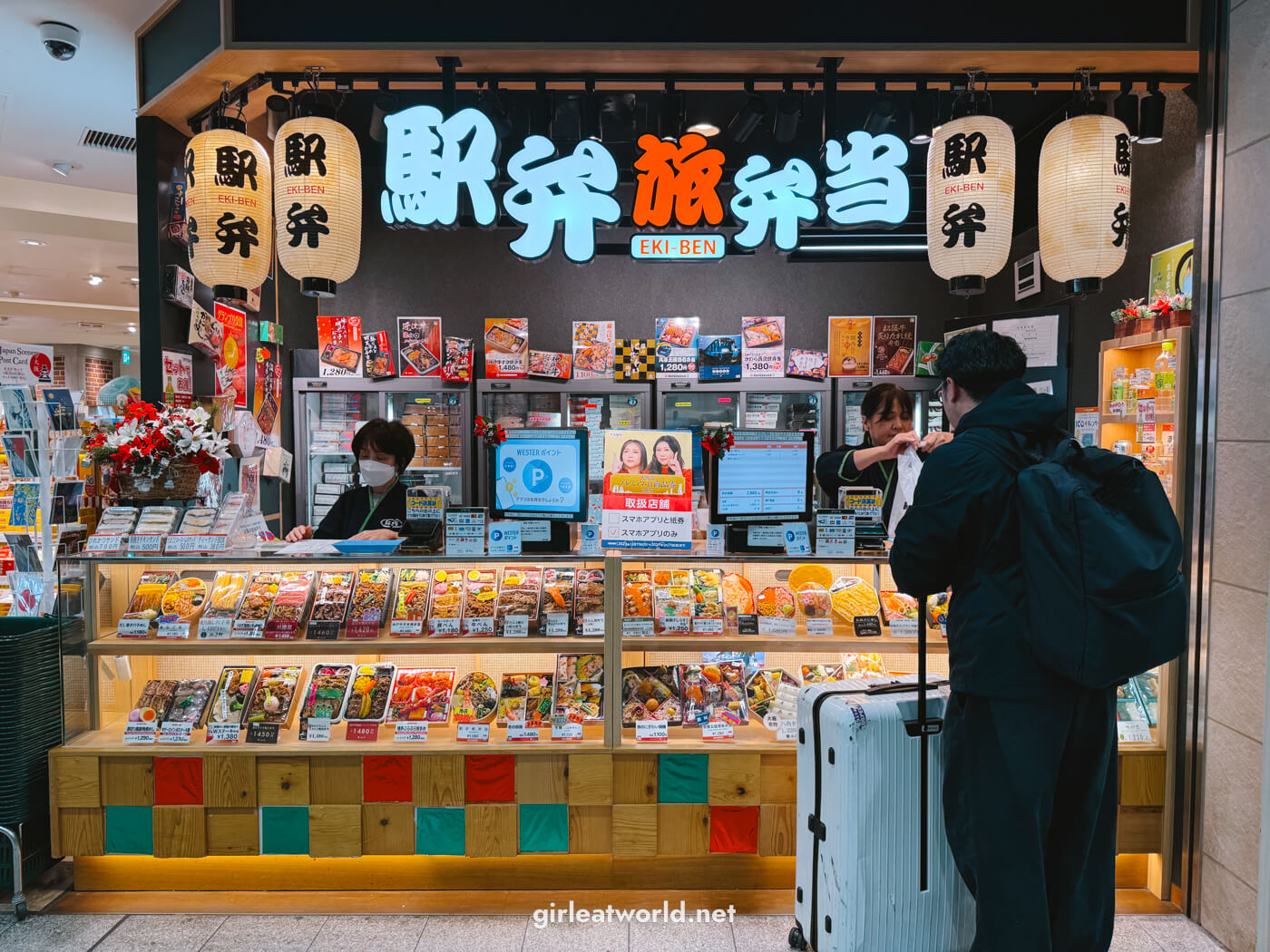
There are plenty of Ekiben to choose from, and they come at an affordable price too. A box of Ekiben starts from 900 yen and can go up to 2,000 yen depending on the ingredients and how elaborate the bento is. To me, choosing an Ekiben is a major part of the excitement of riding a Shinkansen!
Here are some of my picks:
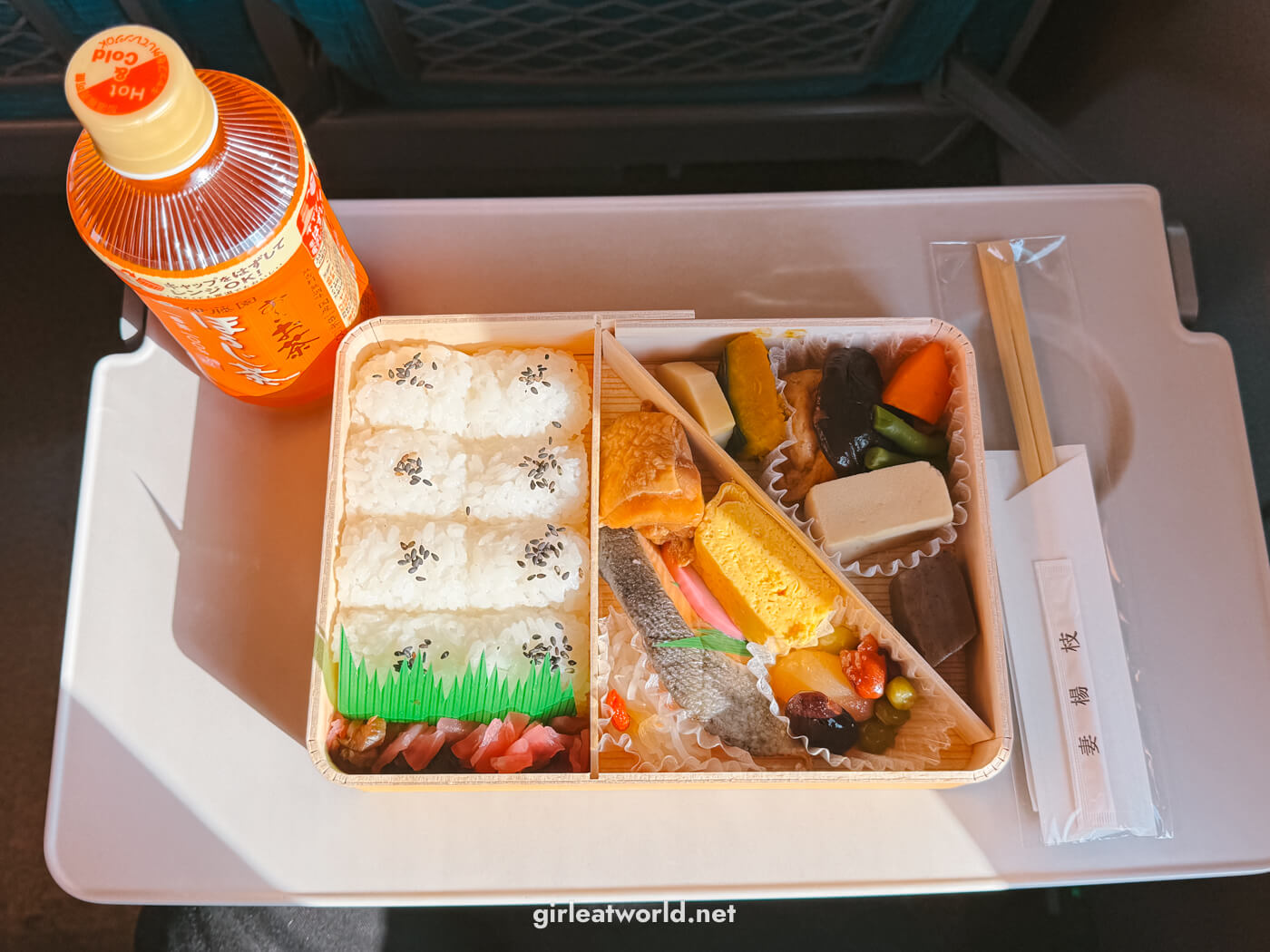

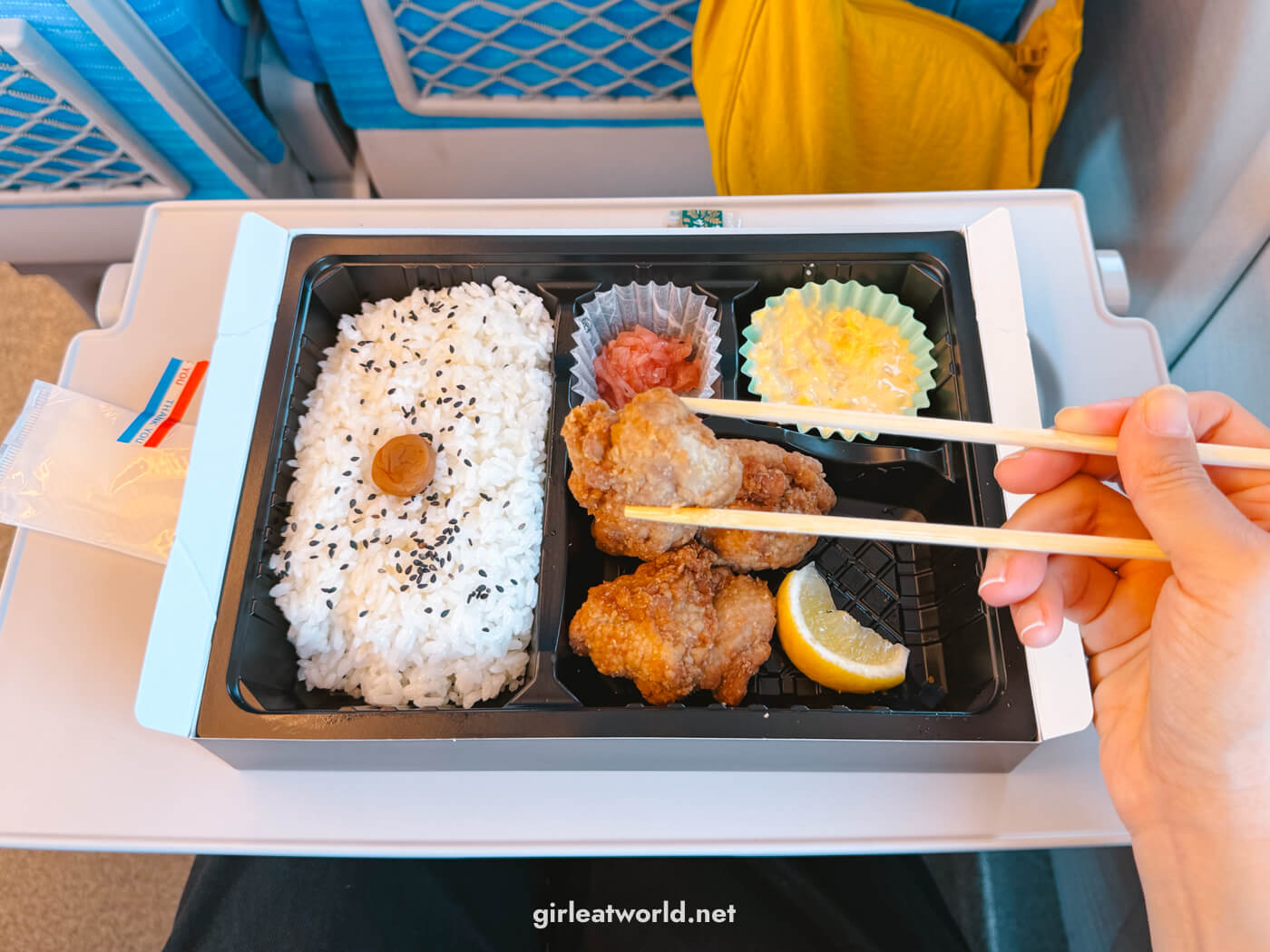
Seeing Mount Fuji from Shinkansen
If you’ve taken the Shinkansen journey between Tokyo and Osaka/Kyoto, you might notice that one side of the window seat is high in demand. That’s because, during the ride, Mount Fuji might be visible for a short 10-minute period!
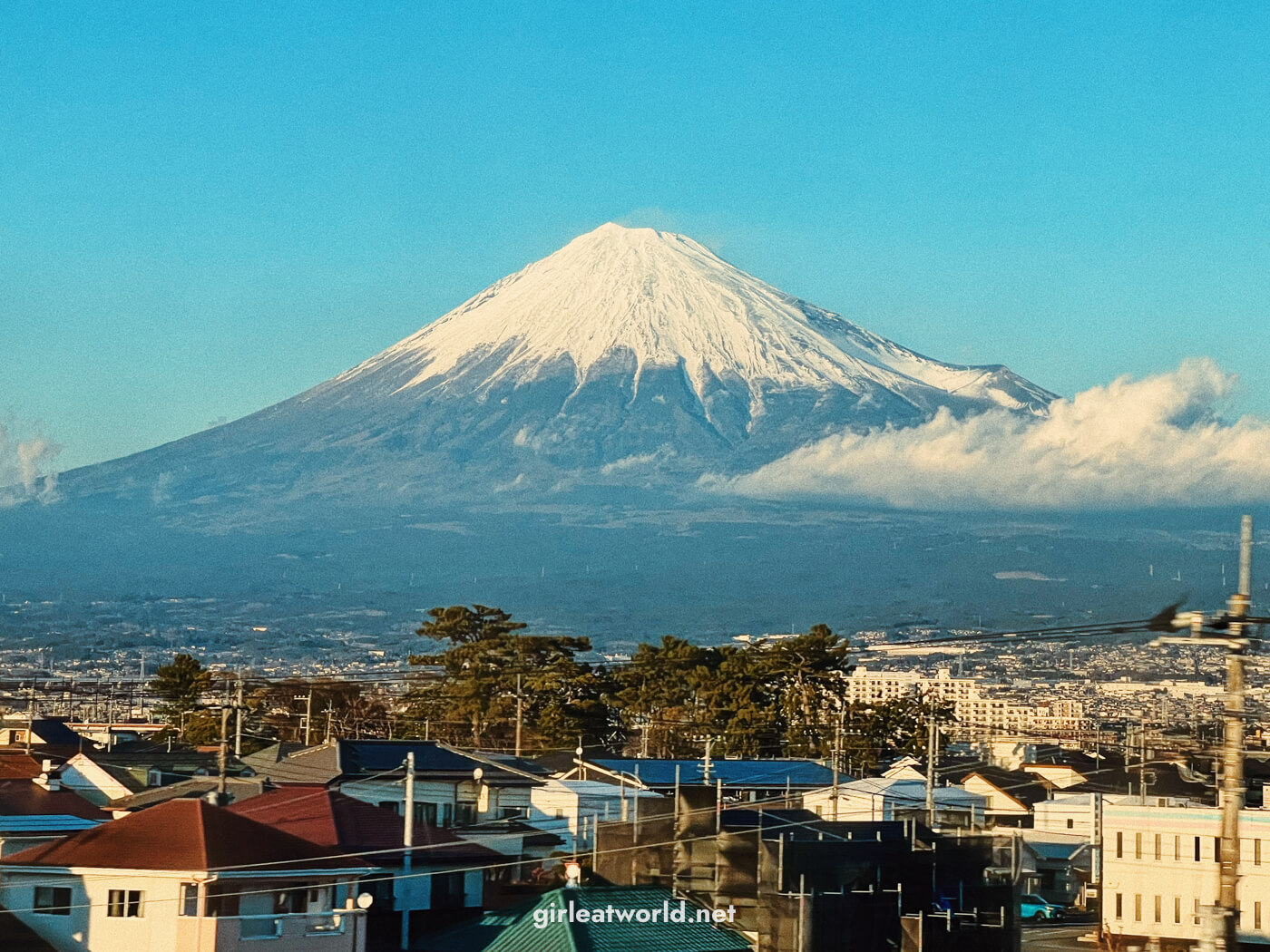
So, as much as possible you’ll want to book the window seat when you’re on the Tokaido Shinkansen. Mount Fuji could be visible on the side facing north – the right-hand side of the train if you’re traveling in the direction of Tokyo to Osaka, and on the left-hand side if you’re traveling from Osaka to Tokyo. But even if you didn’t manage to secure a seat on the correct side, you can also still see Mount Fuji from the windows next to the toilet between each cars.
… if you’re lucky, that is! The weather needs to cooperate for Mount Fuji to be visible. Otherwise, it often hides behind a thick layer of mist. Winter time is usually the best time to see Mount Fuji when the weather is dry and the humidity is low.
And that’s all I know about traveling in Japan with Shinkansen and JR Pass! If you have anything to add or any questions, please feel free to comment below
Are you planning a trip to Japan? I’ve written loads about the beautiful country. Check out the ‘Japan’ category of this blog for some travel inspiration.

Hi Mellisa,
We will be in Tokyo for 3 days, Hakone for 2 days, Kyoto for 3 days and then we got to Kanazawa for 1 day and travel back to Tokyo for 1 day again before we fly back home. Am I right in thinking a JR pass isn’t really worthwhile in this case? Should we just get an IC card and deal with the trains tickets when we are in Japan?
Thanks so much for your help!
Hi Rico! at first glance yes JR pass doesn’t make sense because you’re covering multiple regions. for Hakone, Hakone pass might make sense as it covers all transports within Hakone as well as transport to Hakone from Tokyo.
You can check my Hakone guide for more info
https://girleatworld.net/hakone-travel-guide/
Thank you so much for the detailed info! I bought jr pass online, got an email confirming the purchase but I didn’t get any voucher!?
Hey Irina, where did you buy the pass from?
Bulgaria
I mean which website did you buy it from?
JR official where you can reserve seats. I already reserved seats but I have no voucher
Hi,
I am traveling to Japan around first week of August with a family of 5. Here are some questions that I had:
1.We have 8 days and definitely want to visit Tokyo (+ Disney), Osaka, and Kyoto. Do you think we can still try to explore more cities? How should we spread our itinerary to have time for all those places? When traveling to Osaka and Kyoto, should we only stay in a hotel at one city and go to a day trip for the other, or stay in both areas? We would like to experience a “traditional” setting in a hotel.
2. For traveling, we’re not sure if we should rent a car to travel between all the cities. Is it just more convenient for a JR pass? Since we have a lot of people traveling, it may be very expensive.
Thanks!
Hey Serena,
Cars are convenient, but you have to know that parking costs a lot in Japan, especially in major cities like Tokyo, Osaka and Kyoto. I have driven around quite a bit in Japan and it’s definitely for convenience, not cost savings. I wrote about it briefly in my Kyoto itinerary.
For 8 days, it’s doable to visit all 3 cities, I recommend 4 days in Tokyo then take Shinkansen to Kyoto or Osaka. I recommend 2 days in Kyoto and 2 days in Osaka. If you’re cost conscious, stay in Osaka and just take trains to Kyoto everyday. But if you really want to do the traditional ryokan experience, you can try one night in Kyoto (it won’t be cheap).
Also for those 3 cities only, I don’t recommend JR pass. Kyoto <> Osaka can be done via local train for much cheaper.
Please have a look at these posts to plan the Osaka portion of your trip.
I also have a Tokyo itinerary post you can look at
Hi Melissa,
Thank you for writing such a details blog. I am travelling to Japan end of October. I will start my journey from Tokyo for 5days and move on to Kyoto for 4days and the final city Osaka for 3.5days.
Could you tell me which city do i need the JR pass and Shinkansen train ticket?
And for my 5days in Tokyo is it better to get the JR pass or i just use the Suica card to tap in and out for each train ride?
Looking forward to your suggestion and reply. Thank you so much!
Hey Calin, if you’re just visiting to those 3 cities, I don’t recommend getting JR Pass. It’s not worth it. Get a Suica for traveling within Tokyo, and for travels within inside the cities in Kyoto and Osaka. I think you can even use Suica for going from Osaka to Kyoto since it’s not very far. For traveling from Tokyo to Kyoto, you can purchase a Shinkansen ride separately here.